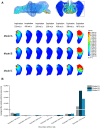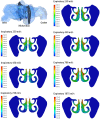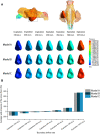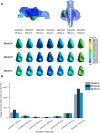Characterizing the respiratory-induced mechanical stimulation at the maxillary sinus floor following sinus augmentation by computational fluid dynamics
- PMID: 35957638
- PMCID: PMC9360545
- DOI: 10.3389/fbioe.2022.885130
Characterizing the respiratory-induced mechanical stimulation at the maxillary sinus floor following sinus augmentation by computational fluid dynamics
Abstract
Background: The relationship between maxillary sinus pneumatization and respiratory-induced fluid mechanics remains unclear. The purpose of this study was to simulate and measure the respiratory-induced mechanical stimulation at the sinus floor under different respiratory conditions and to investigate its potential effect on the elevated sinus following sinus-lifting procedures. Methods: The nasal airway together with the bilateral maxillary sinuses of the selected patient was segmented and digitally modeled from a computed tomographic image. The sinus floors of the models were elevated by simulated sinus augmentations using computer-aided design. The numerical simulations of sinus fluid motion under different respiratory conditions were performed using a computational fluid dynamics (CFD) algorithm. Sinus wall shear stress and static pressure on the pre-surgical and altered sinus floors were examined and quantitatively compared. Results: Streamlines with minimum airflow velocity were visualized in the sinus. The sinus floor pressure and the wall shear stress increased with the elevated inlet flow rate, but the magnitude of these mechanical stimulations remained at a negligible level. The surgical technique and elevated height had no significant influence on the wall pressure and the fluid mechanics. Conclusion: This study shows that respiratory-induced mechanical stimulation in the sinus floor is negligible before and after sinus augmentation.
Keywords: biomechanics; fluid dynamics; maxillary sinus floor augmentation; re-pneumatization; respiratory airflow.
Copyright © 2022 Li, Wang, Wang and Wang.
Conflict of interest statement
The authors declare that the research was conducted in the absence of any commercial or financial relationships that could be construed as a potential conflict of interest.
Figures







Similar articles
-
Modelling Intra-Sinus Fluid Movements and Drainage Through Computational Fluid Dynamics Before and After Maxillary Sinus Augmentation: A Simulation-Based Pilot Study.J Clin Med. 2024 Dec 26;14(1):60. doi: 10.3390/jcm14010060. J Clin Med. 2024. PMID: 39797143 Free PMC article.
-
Characterizing airflow profile in the postoperative maxillary sinus by using computational fluid dynamics modeling: A pilot study.Am J Rhinol Allergy. 2016 Jan-Feb;30(1):29-36. doi: 10.2500/ajra.2016.30.4266. Am J Rhinol Allergy. 2016. PMID: 26867527
-
Quantification of airflow into the maxillary sinuses before and after functional endoscopic sinus surgery.Int Forum Allergy Rhinol. 2013 Oct;3(10):834-40. doi: 10.1002/alr.21203. Epub 2013 Sep 5. Int Forum Allergy Rhinol. 2013. PMID: 24009143 Free PMC article.
-
Patient specific CFD models of nasal airflow: overview of methods and challenges.J Biomech. 2013 Jan 18;46(2):299-306. doi: 10.1016/j.jbiomech.2012.11.022. Epub 2012 Dec 20. J Biomech. 2013. PMID: 23261244 Review.
-
Computational fluid dynamics modelling of human upper airway: A review.Comput Methods Programs Biomed. 2020 Nov;196:105627. doi: 10.1016/j.cmpb.2020.105627. Epub 2020 Jun 26. Comput Methods Programs Biomed. 2020. PMID: 32629222 Free PMC article. Review.
Cited by
-
Comparison of biomechanical characteristics of the Schneiderian membrane with different transcrestal sinus floor elevation techniques using three-dimensional finite element analysis.BMC Oral Health. 2025 Jan 28;25(1):146. doi: 10.1186/s12903-025-05499-0. BMC Oral Health. 2025. PMID: 39875935 Free PMC article.
-
Modelling Intra-Sinus Fluid Movements and Drainage Through Computational Fluid Dynamics Before and After Maxillary Sinus Augmentation: A Simulation-Based Pilot Study.J Clin Med. 2024 Dec 26;14(1):60. doi: 10.3390/jcm14010060. J Clin Med. 2024. PMID: 39797143 Free PMC article.
References
-
- Berberi A., Bouserhal L., Nader N., Assaf R. B., Nassif N. B., Bouserhal J., et al. (2015). Evaluation of three-dimensional volumetric changes after sinus floor augmentation with mineralized cortical bone allograft. J. Maxillofac. Oral Surg. 14 (3), 624–629. 10.1007/s12663-014-0736-3 - DOI - PMC - PubMed
LinkOut - more resources
Full Text Sources
Miscellaneous

